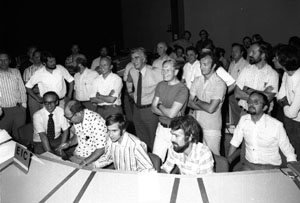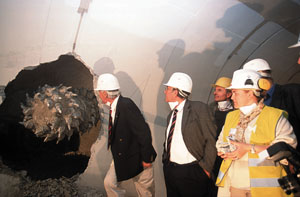A quarter of a century ago, CERN’s gleaming new Super Proton Synchrotron supplied its first proton beams. Although no longer the spearhead of CERN’s research programme, the machine has become a vital part of CERN’s unique interconnected accelerator network and continues to meet new challenges.

On the afternoon of 17 June 1976, CERN executive director-general John Adams addressed the CERN governing body, Council. After he had reported on the operation status of CERN’s various accelerators, he turned to its newest addition, the Super Proton Synchrotron (SPS), and announced that the machine had just accelerated protons to 300 GeV – the energy specified in the programme previously approved by Council.
With the dignified aplomb that characterizes the making of CERN’s major decisions, Adams then politely consulted Council about increasing the energy of the machine to 400 GeV, a possibility that had been formally discussed three years earlier. The motion was duly approved at 1530 h. Five minutes later, as Council continued its formal business, Adams was able to inform the meeting that the SPS had duly delivered 400 GeV protons.
Adams had always had a fine sense of occasion when announcing the successful operation of his new machines. Some 17 years earlier, in November 1959, he had displayed an empty bottle of vodka during his announcement to CERN staff that the Proton Synchrotron (PS) had reached its design energy of 25 GeV. He had been given the full bottle several months earlier on a trip to Dubna in the Soviet Union, with strict instructions that it should be drunk immediately after the PS had surpassed the world record energy of 10 GeV, then held by Dubna’s synchrophasotron.
However, the 400 GeV achieved by the SPS on 17 June 1976 was not a world record. In the US, Fermilab’s Main Ring, the 6.4 km circumference of which was comparable to that of the SPS, had already been in operation for several years. On 14 May 1976, a matter of days after the SPS had achieved an initial circulating proton beam (with no accelerating radiofrequency power) on 3 May, Fermilab took its protons all the way to 500 GeV. This achievement provided the opportunity to introduce a new energy scale, the teraelectronvolt (TeV), equal to 1000 GeV. The Fermilab Main Ring had become a 0.5 TeV machine.
A proud moment for Europe in June 1976 had, therefore, already been upstaged by Fermilab. CERN had lost the multihundred giga-electronvolt synchrotron race, and the European community gritted its teeth and prepared for the next round.
On the table this time was Carlo Rubbia’s proposal to convert a multihundred GeV synchrotron like Fermilab’s Main Ring or CERN’s SPS into a proton-antiproton collider. Fermilab left this imaginative proposal where it was, having initially preferred to build a second ring, this time superconducting, to merit the title of Tevatron. In this way Fermilab pioneered a cryogenic route to large proton synchrotrons.

CERN, though, picked up the proton-antiproton collider challenge and resolutely sprinted with it all the way to the finish line. The new CERN proton-antiproton complex provided its first collisions in 1981, and two years later it was the scene of the epic discovery of the W and Z boson carriers of the weak interactions.
Since it was commissioned in 1976, the SPS has learned how to accelerate antiprotons (for the SPS proton-antiproton collider), electrons and positrons (the SPS was the injector for CERN’s LEP electron-positron collider) and heavy ions (for a new research programme that began in the mid-1980s). The proton-antiproton collider is no more, and nor is LEP, but the veteran SPS is still having to learn many more new tricks to supply high-intensity proton beams to CERN’s LHC collider, which is scheduled to begin operations in 2006. The SPS will also be supplying the particles that will generate the neutrinos to be sent to the Italian Gran Sasso laboratory 730 km away. This year, to celebrate its 25th birthday, the SPS is supplying proton beams for a major physics run.
It is a tribute to John Adams and the team that designed and built the SPS that their machine has met all of the challenges of the past 25 years, and will surely continue this tradition in the future. The precision of the SPS survey and construction work, the sheer perfection of its magnets, its computer-driven control system and its robust power supplies have all contributed to this success. Foresight has been the key.
In addition, the SPS was CERN’s first machine to straddle an international frontier, breaking new ground in diplomacy and administration as well as in science and technology. The SPS supplied (and continues to supply) beams to two distinct experimental areas – one on the main CERN Meyrin site and the other on the Prévessin site, several kilometres away.
A second CERN
The initial proposal had been that the SPS would be built on an entirely new “greenfield” site somewhere else in Europe: a second CERN. Countries vied with one another to host the new machine, and political wrangling delayed a final decision. It took the Solomonic wisdom of John Adams to convince everybody of the advantages of building a new machine next to CERN’s existing site and using the Proton Synchrotron as the injector.
The idea was accepted, but the second CERN still went ahead. While the SPS was being constructed in the early 1970s, these two sites were known as CERN I (the original site based on Swiss territory) and CERN II (in France), and each site was run by its own director-general. Despite the obvious advantages of inherited proton infrastructure, grafting a CERN site in France onto one based in Switzerland had called for some imaginative administration. The two sites also looked very different, with the CERN II buildings harmonizing with their verdant surroundings in stark contrast with the postwar utility concrete of the original CERN site.
In 1975, CERN Council voted to merge the two laboratories, but a vestigial duality was to remain for another five years, with two director-generals heading the laboratory: John Adams as executive director-general of the united laboratory and Leon Van Hove as its research director-general. It was not until 1981 that the larger CERN came under a single director-general, Herwig Schopper.
Preparing for the future

The SPS will be the final pre-injector for the LHC, accelerating 26 GeV protons from the PS to 450 GeV before extraction via two specially built links connecting the SPS and the LHC ring tunnels (figure 2). Many changes to the existing SPS will be necessary before it can deliver the high-brightness proton beams required by the LHC.
To accomplish this, the main hardware modifications and additions will include an upgrade to the existing 200 MHz travelling wave radiofrequency system; the construction of a new extraction channel and modification to the existing ones; upgrades to the beam instrumentation, the transverse damper, the transfer lines, and the injection and extraction kickers; the development of a fast beam scraper; and an upgrade to the internal beam dump. Measures to reduce the impedance will also be taken.
This programme is already well under way, and work last year had to be conducted in such a way that LEP operations were not disturbed. During the past seven-month shutdown, the SPS has received a major facelift. In addition to the work already mentioned, the civil engineering required to connect the new transfer tunnels to the LHC ring tunnel has been carried out and major changes to the infrastructure and services for the machine have been made.
Reducing the impedance of the machine has involved clearing out all of the equipment previously used to provide beams to the LEP and the installation of shields to smooth the transitions in the vacuum chambers around the machine. This last activity alone involved removing and reinstalling half of the main magnets of the machine (some 400 in total) and most of the auxiliary magnets, requiring the displacement of around 8000 tonnes of material.
Work on upgrading the SPS will continue during the next two annual shutdowns, by which time all of the elements will be in place to allow commissioning of the new extraction channel in time for the first LHC injection tests, planned for 2004. One year later, the same extraction channel will be used to send a high-intensity proton beam towards a target for the CERN-Gran Sasso project for long-distance neutrino experiments. From 2006, the SPS will have to deliver a 450 GeV proton beam to the LHC on demand, as well as beams for Gran Sasso neutrinos and for the current experimental areas. During 2007, high-brightness heavy-ion (initially lead) beams for the LHC at 177 GeV per nucleon will be added to its repertoire. Plans for intermediate ions for LHC in later years are already under way.
The future of the SPS is assured for a long time to come.
Further reading
As the midsummer Sun rose over the Alps on 17 June 1976, the team commissioning CERN’s new Super Proton Synchrotron began to assemble in the control room. We were going to try, yet again, to push the beam to its design energy. We had spent several days setting up the extracted 10 GeV beam from the PS synchrotron, guiding it along Bas de Raad’s TT10 transport line and through his injection kickers into the ring.
In the SPS control room, those responsible for the construction of the SPS hardware systems, Roy Billinge for magnets, Clemens Zettler for radiofrequency and Simon van der Meer for power supplies, would start their components pulsing to follow the heartbeat of injection.
A new kind of control system – a network of Norsk Data minicomputers that was the brainchild of Michael Crowley Milling – would set the tempo, while I, helped by the American Ray Stiening (as I was when we had coaxed Fermilab’s Main Ring into life several years before), went through the many tuning processes needed – setting the injection field, correcting the orbit and measuring chromaticity and resonance Q factor – to bring the beam in.
Just before lunch the beam was circulating at full strength, but dying as the radiofrequency captured it and the power supplies for dipoles and quadrupoles were tuned to keep in step and guide the beam through its acceleration cycle. Clearly something was wrong, and project director John Adams began to wonder if some obstruction – even someone’s sandwiches – had been left in Bo Angerth’s vacuum system. Could it be that Jean Gervaise’s impeccable survey had made a millimetric error in the 7 km circumference of this huge monster, crafted out of steel and copper by Hans Horisberger’s engineers and installed in the tunnel built by Robert Levy-Mandel? We had heard another lab director in another place invoke vacuum chamber obstructions to explain beam loss, but we remained convinced that careful measurement of orbit and resonance Q would unlock the secret. This it did.
Just before lunch, a close examination of the behaviour and Q in the first few parabolic giga-electronvolts of the power supply cycle showed that it took a dive to an integer stop band. The “obstacle” was in the software, which matched the quadrupoles to the dipoles. A rapid debate revealed that an obsolete conversion factor for the bus bar shunts had been used. With this corrected, the beam winged its way through transition to 200 and then 300 GeV.Council was in session as Adams announced that his baby had been delivered. Permission was duly given to increase the machine’s energy to 400 GeV, and up it went – a fat trace on the oscilloscope up to and beyond the plateau in the magnet cycle. Celebrations took place and – typical of the planning that had brought this machine to life on time and on budget – the champagne was found to have been well chilled in advance.
Ted Wilson, CERN





